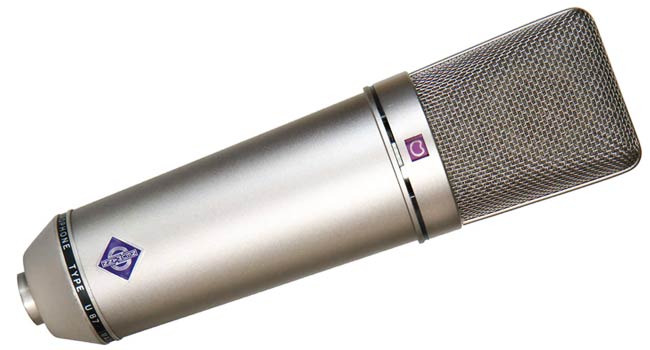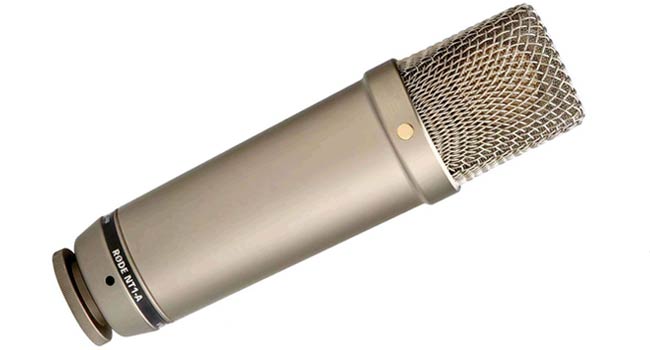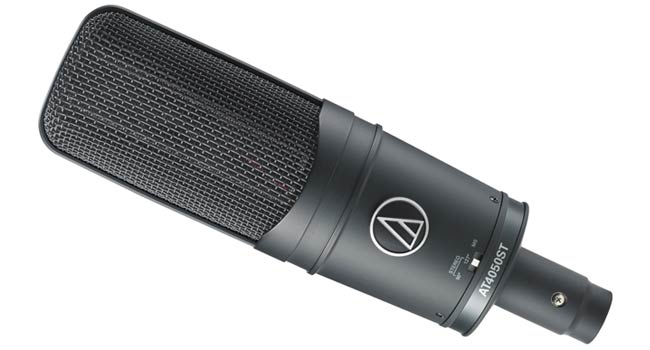- Published Nov 12, 2013 in Gear Garage
The mic you pick for your vocal session will have a huge effect on the sound of the vocal track from recording to mixing to mastering. So pick a good one.
I got wind that a lot of folks found the vocal EQ article particularly helpful, so breaking from the EQ series momentarily, I'll expand on vocals a little by talking about specific microphones and what situations to use them in, particularly in relation to vocals.
Neumann U87
Variable Large Diaphragm Condenser

Neumann's ageless large-diaphragm condenser was designed in 1967 and hasn't changed much since. As with all condenser mics, it requires +48V Phantom power. The microphone, for its nearly 40 years of existence, has been a comparison point for all similar mics since—and for good reason. Aside from it harboring a warm, poignant sound for the most diverse of singers, it is quite durable. While its best to keep it several inches back from a guitar amp, it is perfectly suitable for a variety of applications including drum overheads or acoustic instruments.
- Directional Pattern Omnidirectional, Cardioid, Figure-8
- Maximum SPL 117-127dB
- Rated Impedance 200 ohms
- Price $3,199
- More info www.Neuman.com
Neumann TLM-103
Large Diaphragm Cardioid

Neumann's answer to its own pre-established standard, the TLM is another large diaphragm condenser, albeit smaller than the U87. It also sets a new standard in versatility with it's ability to withstand more sound level (about 138 db) and offering a more "airy" frequency response. The mic is similar to the U87 up to around 5 kHz, until a wide 4dB or so lift occurs. This definitely helps with adding a brighter presence, flattering vocalists and cymbals alike. I talked about why we liked this frequency range in EQ Series,Part 1: Vocals.
- Directional Pattern Cardioid
- Maximum SPL 138dB
- Rated Impedance 50 ohms
- Price $1,099
- More info www.Neuman.com
Yeah, those are expensive.
Considering a large diaphragm condenser for your vocals is obviously your first step. Your next thought is likely: Ok, so how much is this going to put me out?
Microphone technology today is so much better that there are several cost-effective mics out there that offer a lot of the features that would've cost several thousand dollars a decade ago. Manufacturers have figured out how to reduce mechanical noise, increase SPL temperament, and thus make mics that are much more versatile (hence more appealing) to the average consumer needing a single mic for multiple applications.
Here are a couple high-quality, but less expensive mics:
RØDE NT1-A
1" Cardioid Condenser

Australia's RØDE microphones have taken a lead in the consumer/prosumer industry by offering very decent microphones at appealing prices. This mic was their flagship for years, and still remains a very good mic. With very low mechanical noise, a maximum SPL of 137dB, a flat (and very predictable) frequency curve, and a cost of around $230, this mic is great for many things, including vocals. While it doesn't have that mid-high frequency lift with the flat curve, it does allow you to effectively use EQ for enhancement without having to think too much about damage control.
- Directional Pattern Cardioid
- Maximum SPL 137dB
- Rated Impedance 100 ohms
- Price $239
- More info www.RODEmic.com
Audio Technica AT4050
Multi-pattern Condenser

Another variety of large diaphragm microphones are tube mics. These come in all shapes, sizes and types, and are powered not by the +48V Phantom power in your mic-pre, but by their own separate tube-driven power source. This often gives tube mics other colors, and thus can be nice for vocal applications.
Not only is this my favorite tube mic, it is my favorite vocal mic altogether. It's not too hyped, and usually can give you a very controlled sound right through the pre. Again, low self noise and high SPL (150dB) capability make it very versatile. Frequency response-wise it lifts at 7kHz and 11kHz, adding some very nice clarity for vocal applications. There's also a 10dB pad.
- Directional Pattern Omnidirectional, Cardioid, Figure-8
- Maximum SPL 149-159dB
- Rated Impedance 100 ohms
- Price $699
- More info www.Audio-Technica.com
Your mic-pre matters too.
Your microphone is the most important factor in establishing what your vocals are going to sound like, but a close second is your mic-pre. There are as many, if not more, mic-pre choices than mics out there, and deciding can be a challenge.
Reading reviews in unbiased publications is a good start. Sound On Sound comes to mind. Also, think about your favorite albums and the vocal sounds you hear on them. With the internet and liner notes, it's not too hard to find out who recorded it and where (and often with what), and with articles or studio equipment lists, you can often get a good idea of what "good" sounds like.
As highlighted in some of my other writings, your environment plays a key role in your sound, and that combination of a quiet, controlled environment, dependable mic-pre, and consistent and predictable microphone are going to make you look and sound good.
It's always a balance of cost vs. quality when playing consumer, so consider all of those things. An SM-57 in an iso-booth is no more helpful than a $5,000 condenser in a boiler room.

